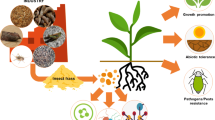Abstract
Hydroxamic acids have been shown to be toxic to many pest insects and pathogens. In this study, the behavioral responses of western corn rootworm larvae to naturally occurring and synthetic hydroxamic acids were investigated. In a choice test between corn roots treated with hydroxamic acids and roots treated with distilled water (control), western corn rootworm larvae chose to burrow into the control roots significantly more often than compoundtreated roots. In addition, when corn roots were treated with different hydroxamic acids in a designed searching-behavior test, neonate larvae of western corn rootworm responded by significantly reducing the number of turns, while the area searched and locomotor rate significantly increased. The responses were dependent on the concentrations of the test compounds. These results suggested that hydroxamic acids were acting as behavior-modifying and possibly feeding-deterrent chemicals.
Similar content being viewed by others
References
Anonymous. 1991. Statistix (3.5) User's Manual. Analytical Software, St. Paul, MN.
Argando¯na, V.H., Corcuera, L.J., Niemeyer, N.M., andCampbell, B.C. 1983. Toxicity and feeding deterrency of hydroxamic acids from Gramineae in synthetic diets against the greenbug,Schizaphis graminum.Entomol. Exp. Appl. 34:134–138.
Atkinson, J.K. 1989. A Structure-Activity Study of Naturally Occurring and Synthetic Hydroxamic Acids, Ph.D. thesis. University of Ottawa, Ottawa.
Bell, W.J. 1985. Sources of information controlling motor patterns in arthropod local search orientation.J. Insect Physiol. 31:837–847.
Branson, T.F. 1986. Larval feeding behaviour and host-plant resistance in maize, pp. 159–182,in J.L. Krysan andT.A. Miller (eds.). Methods for the Study of PestDiabrotica. Springer-Verlag, New York.
Campos, F., Atkinson, J., Arnason, J.T., Philogéne, B.J.R., Morand, P., Werstiuk, N.H., andTimmins, G. 1988. Toxicity and toxicokinetics of 6-methoxybenzoxazolinone (MBOA) in the European corn borer,Ostrinia nubilalis (Hübner).J. Chem. Ecol. 14:989–1002.
Campos, F., Atkinson, J., Arnason, J.T., Philogéne, B.J.R., Morand, P., Werstiuk, N.H., andTimmins, G. 1989. Toxicokinetics of 2,4-dihydroxy-7-methoxy-1,4-benzoxazin (DIMBOA) in the European corn borer,Ostrinia nubilalis (Hübner).J. Chem. Ecol. 15:1989–2001.
Hibbard, B.E., andBjostad, L.B. 1988. Behavioral responses of western corn rootworm larvae to volatile semiochemicals from corn seedlings.J. Chem. Ecol. 14:1523–1539.
Hibbard, B.E., andBjostad, L.B. 1990. Isolation of corn semiochemicals attractive and repellent to western corn rootworm larvae.J. Chem. Ecol. 16:3425–3439.
Honkanen, E., andVirtanen, A.I. 1960. The synthesis of precursor II of benzoxazolinone in rye plants, and the enzymatic hydrolysis of precursor I, the glucoside.Acta Chem. Scand. 14:504–507.
Jander, R.J. 1975. Ecological aspects of spatial orientation. A.Rev. Syst. Ecol. 6:171–188.
Klun, J.A., andBrindley, T.A. 1966. Role of 6-methoxybenzoxazolinone in inbred resistance of host plant (maize) to first-brood larvae of European corn borer.J. Econ. Entomol. 59:711–718.
Long, B.J., Dunn, G.M., Bowman, J.S., andRouley, D.G. 1977. Relationship of hydroxamic acids content in corn and resistance to the corn leaf aphids.Crop Sci. 17:55–58.
Prystupa, B., Ellis, C.R., andTeal, P.E.A. 1988. Attraction of adultDiabrotica (Coleoptera: Chrysomelidae) to corn silks and analysis of the host-finding response.J. Chem. Ecol. 14:635–651.
Robinson, J.F., Klun, J.A., Guthrie, W.D., andBrindley, T.A. 1982. European corn borer (Lepidoptera: Pyralidae) leaf feeding resistance. DIMBOA bioassay.J. Kans. Entomol. Soc. 55:357–364.
SAS Institute. 1982. SAS User's Guide: Statistic. SAS Institute, Cary, NC.
Schoonhoven, L.M. 1982. Biological aspects of antifeedants.Entomol. Exp. Appl. 31:57–69.
Snedecor, G.W., andCochran, W.G. 1980. Statistical Methods. Iowa State University, Ames.
Steel, R.G.D., andTorrie, J.H. 1980. Principles and Procedures of Statistics. McGraw-Hill, New York.
Strnad, S.P., andBergman, M.K. 1987. Movement of first-instar western corn rootworms (Coleoptera: Chrysomelidae) in soil.Environ. Entomol. 16:975–978.
Strnad, S.P., andDunn, P.E. 1990. Host search behaviour of neonate western corn rootworm (Diabrotica virgifera virgifera).J. Insect Physiol. 36:201–205.
Strnad, S.P., Bergman, M.K., andFulton, W.C. 1986. First-instar rootworm response to carbon dioxide.Environ. Entomol. 15:839–842.
Suguiyama, L.F., andCarlson, G.A. 1985. Field crop pests: Farmers report the severity and intensity. USDA Scientific & Economic Research Service, Agriculture Information Bulletin 487.
Visser, J.H. 1988. Host-plant finding by insects: orientation, sensory input and search patterns.J. Insect Physiol. 34:259–268.
Wahlroos, Ö., andVirtanen, A.I. 1959. The precursors of 6MBOA in maize and wheat plants: Their isolation and some of their properties.Acta Chem. Scand. 13:1906–1908.
Xie, Y.S. 1991. Role of Hydroxamic Acids in the Resistance of Maize,Zea mays L., to Western Corn Rootworm,Diabrotica virgifera virgifera LeConte, Ph.D. thesis. University of Ottawa, Ottawa.
Xie, Y.S., Arnason, J.T., Philogéne, B.J.R., Lambert, J.D.H., Atkinson, J., andMorand, P. 1990. Role of 2,4-dihydroxy-1,4-benzoxazin-3-one (DIMBOA) in the resistance of maize to western corn rootworm,Diabrotica virgifera virgifera LeConte (Coleoptera: Chrysomelidae).Can. Entomol. 122:1177–1186.
Author information
Authors and Affiliations
Rights and permissions
About this article
Cite this article
Xie, Y., Arnason, J.T., Philogéne, B.J.R. et al. Behavioral responses of western corn rootworm larvae to naturally occurring and synthetic hydroxamic acids. J Chem Ecol 18, 945–957 (1992). https://doi.org/10.1007/BF00980055
Received:
Accepted:
Issue Date:
DOI: https://doi.org/10.1007/BF00980055




